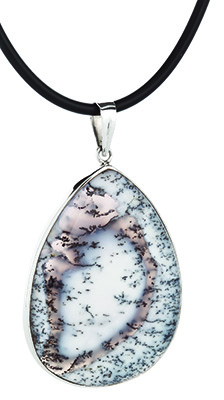
Any gemstone that is recognised for its stress-management properties gets a tick of approval from me, especially one which is Australian and contains dendritic inclusions (one of my favourite features). Australian Dendritic Opal is typically a black and white ornamental gemstone containing areas of opaque white common opal, translucent grey to colourless chalcedony and picturesque black to brown dendritic inclusions of manganese oxides. Although it is often called “Merlinite” in the new-age scene it is however the dendrites that have made this stone popular, not Merlin.
Dendritic is the term used to describe the formation in which certain minerals crystallise; fine, fern-like branches much like the structure of frost and snowflakes. Dendrites are, by definition, a fractal – a “self-similar” pattern, meaning they are the same either near or far, an ever-evolving pattern of repetition and growth. Fractals are fascinating for more than just the dendrite enthusiast.
Mathematicians and scientists have studied their attributes to further their knowledge of geometry, metallurgy, computer technologies, neurosciences, space and time. In the gemmological world dendrites are manganese oxides (MnO2) and form in fine fractures and fissures through the crystallisation of manganese rich solutions from surrounding weathered rock. In the jewellery world they’re simply beautiful and can turn a piece of common opal into something of spectacular beauty and intrigue.
Most people will look at dendritic opal and say “that’s not opal!” but our perception of opal has been skewed by our nation’s abundance of “precious opal” and the magnificent ‘play-of-colour’ it exhibits. Common opal (also referred to as ‘potch’) is precious opal’s not-so-extravagant cousin. Both are silicon dioxide (SiO2) with varying amounts of water (H2O), however the key ingredient of orderly, symmetrical micro-structure of silica spheres that are required to produce flares of spectral light is not present in common opal. Instead they are varying sizes and randomly arranged.
With a hardness of 7, dendritic opal is a good stone for use in jewellery although the water content means extreme temperatures can negatively affect the stone. An original and favourite gemstone of Made In Earth’s collection, Bunny Bedi, owner and director of MIE reminisces about his first experiences of this Australian gem.
“The late Frank Soklich (founder of Soklich Trading Company) was a dear friend of mine and he had mentioned a long time ago that it was dendritic opal which first sparked his lifelong love for gemstones. About 40 years back Frank and his wife Maureen noticed the black and white beauty against the dusty red landscape as they drove through Norseman on a holiday through the West Australian outback. Still to this day it is the best quality I have ever seen and luckily for us we had purchased a large quantity of rough from this location as the site is now covered by railway lines.”
Today, dendritic opal is found in various locations throughout WA and NT. Some international deposits are found in Turkey and Mexico so not all dendritic opal on the market is Australian.
Although it is not deemed ‘precious’, dendritic opal is certainly precious to some. The dendrites in each piece create completely unique patterns and pictures in each cabochon. Whether you’re a jeweller, a gemmologist or a dendrite enthusiast it is no wonder why this stone appeals to so many. And it’s black and white … so it goes with everything!